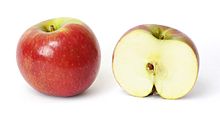 Oral allergy syndrome (OAS) symptoms to apple are frequent.
Oral allergy syndrome (OAS) symptoms to apple are frequent.The researchers aimed to identify low allergenic apple cultivars and to validate the prick-to-prick skin prick test (SPT) as a suitable screening method.
68 apple cultivars were tested by SPTs in 33 Dutch adults with OAS, before and during 2 birch pollen seasons.
3 apple cultivars yielding the largest number of negative SPTs (Elise, Santana and Pink Lady(®)) and one reference cultivar (Golden Delicious) were subsequently tested by single-blind oral food challenges (SBFC).
In fresh apples, OAS symptoms of Elise were lower than those of Santana, Pink Lady and Golden Delicious. Scores of Santana were significantly lower than those of Golden Delicious. Scores of fresh apples did not differ significantly from stored apples, except in Golden Delicious (spring < fall).
The SPTs did not predict the severity of OAS.
The researchers concluded that SPTs are not useful to assess the allergenicity of apple cultivars. By using oral food challenges (SBFC), Elise and Santana were identified as low allergenic apple cultivars in patient with OAS.
Cross-reactivity in Pollen-Food Allergy Syndrome (PFAS) or Oral Allergy Syndrome (OAS) (click to enlarge the image).
References:
Identification of low allergenic apple cultivars using skin prick tests and oral food challenges.
Vlieg-Boerstra BJ, Van De Weg WE, Van Der Heide S, Kerkhof M, Arens P, Heijerman-Peppelman G, Dubois AE. Allergy. 2010 Nov 8. doi: 10.1111/j.1398-9995.2010.02499.x.
Practical guide to skin prick tests in allergy to aeroallergens (free full text). Allergy, 2011.
Image source: Apple, Wikipedia, public domain.
No comments:
Post a Comment